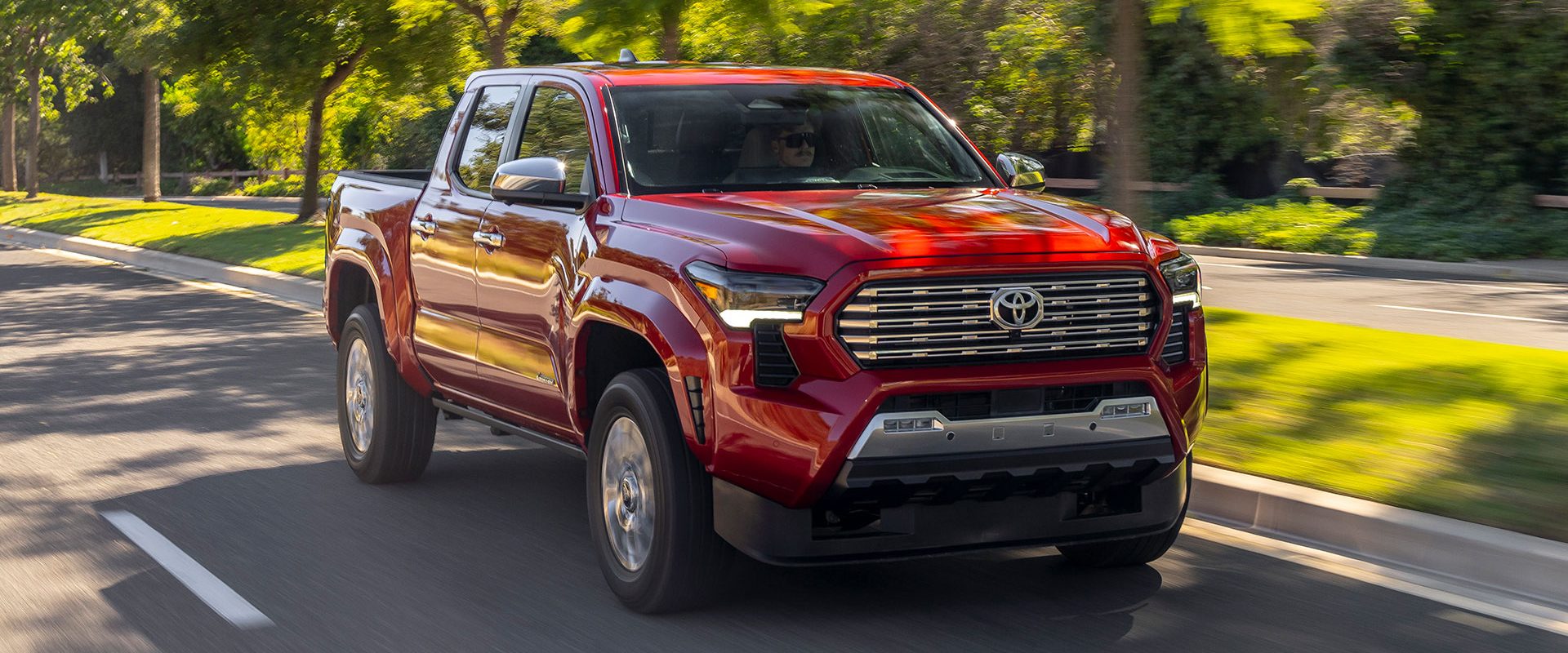2024 Toyota Tacoma
If you’ve been a devout MotorWeek viewer as of late– and really you should be– you’re probably aware of just how many midsize pickup trucks we’ve driven recently.
A long running staple is the Toyota Tacoma, now looking to defend its title as a best seller with an all-new generation. We witnessed the 2024 Tacoma’s big reveal in Hawaii earlier this year, and now we’re back from Southern California with some First Drive impressions.
At a time when consumers may feel limited in their options, the Tacoma remains a very configurable truck. I’m looking at the pricing sheet now, and I count 21 individual combinations– and that’s before including any hybrid models, so we’re just looking at regular i-FORCE units, their grades, cab styles, box lengths, transmissions and power distribution. It’s a lot to go over, so please bear with me. Let’s start with the basics.
Built from the ground-up, the new Tacoma borrows the brand’s TNGA-F global truck platform, shared with the full-size Tundra pickup, as well the Sequoia and Land Cruiser utilities. Buyers can select between a two-door “XtraCab” model with a six-foot bed, or a four-door “Double Cab” flanked by either a six- or five-foot bed.
Toyota is planning to offer eight grades total, starting with the base SR and moving up to the TRD Pro and the new Trailhunter. Those top trims come standard with an i-Force MAX hybrid powertrain; but, all the Tacos on our platter were of the non-hybrid variety, so we’re gonna focus on those today. Hybrid or not, the foundation of the powertrain is a turbocharged 2.4-liter i-FORCE inline-four, available with various power outputs.
The base SR is the lowest with 228 horsepower and 243 lb-ft of torque. The higher grades will output 278 horsepower and 317 lb-ft of torque when paired with the new eight-speed automatic. Max towing on the regular i-FORCE is up to 6,500 lbs; though, the base SR is at 3,500 lbs.
“So, needless to say, the new Tacoma is still a very configurable truck. So, with the different beds, with the different cabs, and with the different powertrains.
For example, I’m in the PreRunner right now. What’s interesting about the PreRunner- so, it’s got that four-cylinder and it’s got the extra power out of it mated to an eight-speed automatic; but, instead of going with the new suspension, it still has the leaf springs in the back. On top of that, it’s two-wheel drive only. So, if you wanna try and find something that’s not quite, you know, all the way at the top, you don’t want all the, uh, all the new stuff; you want something that’s still very much a truck, maybe it’s because you’re a budget conscious buyer, maybe you just want a truck that does truck-things and that’s it. You can probably find a grade of the Tacoma that’ll work for you.”
But that’s not all– Tacoma still offers a six-speed manual, and with this transmission the 2.4-liter makes up to 270 horsepower and 310 lb-ft of torque. The six-speed was easy enough to drive with little ambiguity in the pattern. The clutch was a little high in engagement, but easy to sus out and not much of a lower body workout. Though I will say, the new automatic was my preferred transmission. It’s smooth, quiet and puts the power down no problem– great for daily cruising and plenty capable on the trails.
As expected, the Tacoma can be equipped with four-wheel drive, useful for any off-road excursions, as are the various assistance features. Multi-Terrain Select works in 4-High and 4-Low, allowing drivers to mitigate wheel spin on various surfaces. CRAWL Control acts as an off-road cruise control of sorts, and Downhill Assist Control does exactly what the name suggests.
But one of the more substantial upgrades, be it for overlanding or not, is the new coil spring multi-link rear suspension. Now, good ol’ leaf springs are still standard on base offerings, but the coils serve as a worthwhile upgrade where applicable. They were a bit smoother on SoCal’s mountainous roads, and provided good articulation on the trail; however, I should note spending time in a leaf-spring Tacoma was far from uncomfortable, and about as agile as one could ask from this setup. For a more luxurious ride, the Limited comes with new Adaptive Variable Suspension.
By now you’ve been able to judge the new exterior vibes for yourself, so let’s move inside for a better look.
The cabin on base models is about what you’d expect; that is, cloth-trimmed seating with minimal frills. But it isn’t stripped down, as Toyota has outfitted an 8-inch infotainment screen as standard. Stepping up a few grades means plusher materials and more tech. For example, the standard 7-inch digital gauge cluster grows to 12.3-inches and the touchscreen gets beefed up to a 14-inch display. Heated and ventilated seats are available, and Toyota Safety Sense 3.0 is standard across the board.
Alright, I’ve said a lot of numbers and talked about a lot of different ways to build this thing; so, to avoid it all blending together like one big “Taco in a bag,” let’s wrap up. And what better way to do that than with pricing?
A 2024 Toyota Tacoma starts at $32,995; that’s for an SR XtraCab 4×2 and includes Toyota’s $1,495 processing and handling fee. All other i-FORCE grades fall somewhere between there and the top-trim Limited’s $53,595 starting price. A couple of notable mentions– the PreRunner starts just shy of $40,000, and the TRD Off-Road starts just over $43,000– and that’s with the manual. Add about a grand for the automatic. Expect these midsize pickup trucks to arrive on dealer lots December 2023.
Our official Road Test is just around the bend, and we’ll also have more on the upcoming i-FORCE MAX hybrid models soon. But in the meantime, drive safe and stay tuned to MotorWeek.






